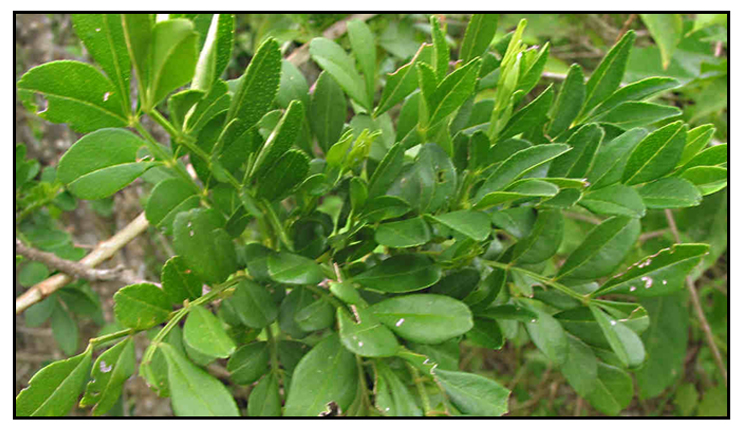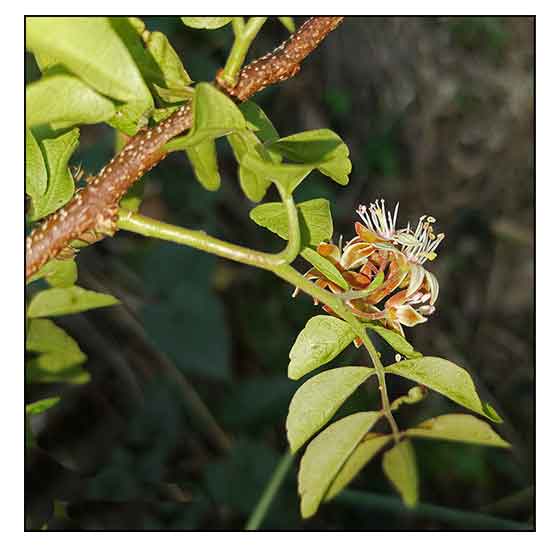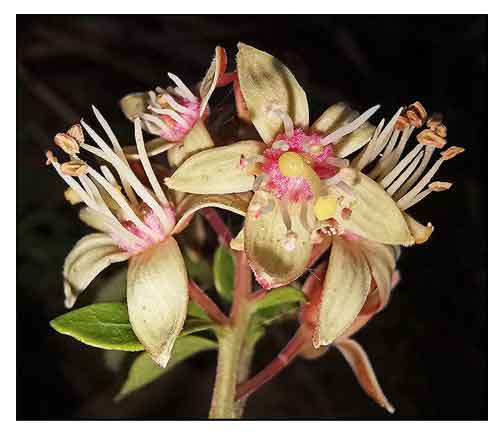 Gen info Gen info
- Harrisonia is a small genus of flowering plants in the subfamily Meteoroid of the Rutaceae (citrus) family. It includes three species: Harrisonia perforata (Blanco) Merr., H. brownii A. Juss, and H. abyssinical Oliv. (32)
 Botany Botany
• Mamikil is a somewhat climbing and nearly erect shrub, growing from 2 to 4 meters in height. Branches are armed with short, sharp spines. Leaves are pinnate, with an unpaired terminal leaflet up to 20 centimeters long. Leaflets are 1 to 15 pairs, oblong-ovate, 1.5 to 3.5 centimeters long, and with entire or crenate margins. Flowers are white, and borne on terminal racemes 3 to 5 centimeters long. Fruit is somewhat globular, fleshy, smooth, and 1 to 1.5 centimeters in diameter.
• Shrubs nearly erect or somewhat climbing, 1-2 m tall. Leaves odd-pinnate, 3-17-foliolate, 3-14 cm; rachis usually winged; leaflet blades equilaterally or inequilaterally ovate to obovate, 1.5-4.5 × 0.7-2 cm, margin crenulate or sometimes entire, in occasional specimens some crenulations with pellucid cavities that seem to lack oil and may be hydathodes. Inflorescences cymose to racemose, to 3 cm, few to many flowered. Flowers bisexual, mostly 5-merous. Sepals ca. 1.5 mm, connate at base or to ± half their length. Petals ovate-elliptic or lanceolate, 5-7 mm. Stamens to 9 mm. Gynoecium usually 5-carpelled and -loculed; ovary glabrous, slightly lobed, ca. 1 mm; style pubescent, to 8 mm. Fruit subglobose, entire or slightly lobed, 1-1.5 cm in diam.; endocarp ca. 1 mm thick. Seeds ca. 3.5 mm. (Flora of China)
 Distribution Distribution
- Native to the Philippines.
-
In thickets at low altitudes in Ilocos Sur, Nueva Viscaya, Pangasinan, Rizal, and Batangas Provinces in Luzon; and in Samar and Mindanao.
- Also native to Andaman Is., Bangladesh, Borneo, Cambodia, China Southeast, Hainan, Jawa, Laos, Lesser Sunda Is., Malaya, Myanmar, Nicobar Is., Philippines, Sulawesi, Sumatera, Thailand, Vietnam. (18)
Constituents
- Roots yield a bitter principle, abundant in the cortical parenchyma. The organic base was provisionally called mamikilina, and the bitter principle, harrisonine.
- Extraction of dried leaves yielded a novel tetranortriterpenoid (limonoid), perforatin, of the obacunol class. (1)
- Study yielded eight limonoids (1–8) including three A, B and D-seco-16-nor-type ones, 5,6-dehydrodesepoxyharperforin C2 (1), harrpernoid B (2), and its C-9S epimer, harrpernoid C (3), along with six known compounds (9–14), were isolated from fruits of Harrisonia perforata. (see study below) (4)
- Fractionation of ethanol extract of fruits yielded 18 compounds[ 12 were elucidated as Ethyl 3,4,5-Trihdroxybenzoate (1)、4-ethylgallic acid (2)、Hydroxyhydroquinone (3)、Gallic acid (4)、β-Sitosterol (5)、β-Daucosterol (6)、Stigmasterol (7)、Protocatechuic acid (8)、Palmitic acid (9)、Linoleic acid (10)、Cis-Oleic acid (11)、5-hydroxymethyl-2-Furancarboxaldehyde (12). (3)
- GC-MS analysis analyzed the chemical constituents of the liposoluble fraction from fruits of H. perforata. Fractionation of a petroleum ether extract yielded 29 compounds, amounting to 69.67% of the total detected constituents. The major constituents were identified as Z-9,12-Octadecadien-1-ol (12.35%), Palmitic acid (9.67%), Z-9,17-octadecadienal (8.97%), Ethyl Oleate (5.81%), β-Sitosterol (4.88%), Ethyl Linoleate (4.10%). Linoleic acid, palmitic acid, and ß-sitosterol were the common liposoluble components in two extractions. (11)
 - Alcohol extraction
yielded 12 compounds amounting to 71.00% of the total detected constituents. The major constituents were identified as Quinic acid (40.44%), pyrogallol (14.64%),5-(hydroxymethyl)-2-Furancarboxaldehyde (5.89%). (3) - Alcohol extraction
yielded 12 compounds amounting to 71.00% of the total detected constituents. The major constituents were identified as Quinic acid (40.44%), pyrogallol (14.64%),5-(hydroxymethyl)-2-Furancarboxaldehyde (5.89%). (3)
- Study of fruit isolated 8 compounds: caryolane-1,9beta-diol (1), gallic acid (2), 4-O-ethylgallic acid (3), syringic acid ethyl ester (4), protocatechuic acid (5), stigmasterol (6), beta-daucoster (7), beta-sitosterol (8). (19)
- Study of H. perforata isolated perforalactone A, a new 20S quassinoid, together with two biosynthetically related new quassinoids.
(see study below) (23)
- Study of bark yielded
three new quassinoids, perforaquassins A, B, and C, and a new limonoid, perforin A. (25)
- Study isolated two new 16-nor limonoids, harperspinoids A and B (1 and 2), with a unique 7/5/5/6/5 ring system along with known Harperforin (3). (see study below) (33)
- Study of branches isolated a new chromone, perforamone D acetate (1), together with six known chromones, peucenin-7-methyl ether (2), alloptaeroxylin (3), O-methylalloptaeroxylin (4), perforamone D (5), perforatic acid (6) and perforatic acid methyl ester (7).
(35)
- Study of bark isolated a novel rearranged limonoid, foritin (1). (36)
- Study of branches isolated 14 compounds, identified as: noreugenin (1), saikochromone A (2), 5,7-dimethoxy-2-methylchromone (3), 2-hydroxymethylalloptaeroxylin (4), ethylparaben (5), propiophenone (6), cephafortin B (7), dehydroconiferyl alcohol (8), hawthornnin C (9), hawthornnin D (10), syringaresinol (11), medioresinol (12), 4-ketopinoresinol (13) and matairesinol (14). (see study below) (37)
Properties
- Antidiarrheal, anti-dysentery.
- Studies suggest antimicrobial, antioxidant, anti-malarial, anti-inflammatory, antidiabetic, antitumor, 11-ß-HSD1 inhibitory, anti-Parkinson properties.
Parts used
Shoots, bark, stems, leaves.
Uses
Folkloric
- In the Philippines, decoction of root bark used as remedy for diarrhea and dysentery; also used against cholera.
- Decoction of stems used for diarrhea.
- In the Dutch East Indies, shoots are used as a remedy for diarrhea.
- In Thailand, the wood was also recorded as medicinal. Roots used in treatment of fever.
- Ashes of roasted leaves mixed with oil and applied locally to relieve itching; crushed leaves also used for the same.
- Harrisonia perforata is one of five root components of Benchalokawichian (BCW), a Thai traditional herbal formulation, used as antipyretic and to treat skin disorders. (10)
- In Laos, root decoction drunk post-partum and during lactation. Also used for diarrhea. (38)
Others
- Veterinary: In Laos, roots boiled roots are mashed in salted decoction, the mixture given to elephants for treatment of constipation. (38)
Studies
• Antimalarial: A South Vietnam study identified 49 plants traditionally used to treat malaria. Harrisonia perforata was one of six plants with possible novel antimalarial compounds, with antiplasmodial activity (IC50 ranging from 0.4 to 8.6 mu g/ml) with good selectivity. (2)
• Antioxidant / Radical Scavenging: Parts of petroleum ether, ethyl acetate and ethanol extract showed high antioxidant activity by the DPPH free radical scavenging method. (11) An ethanolic extract of H. perforata exhibited 84.47% superoxide radical inhibition. (28)
• Limonoids / Cytotoxicity / Fruit: Study of fruits yielded eight limonoids (1–8) including three A, B and D-seco-16-nor-type ones, 5,6-dehydrodesepoxyharperforin C2 (1), harrpernoid B (2), and its C-9S epimer, harrpernoid C (3), along with six known compounds (9–14). Limonoids 1-8 were evaluated for anti-tobacco mosaic virus and in vitro cytotoxicity against A549 and HL60 cell lines. Only compound 2, harrpernoid B, showed weak cytotoxicity. (see constituents above) (4)
• Antimicrobial Activity: In a Cambodian study of 27 plant species for in vitro antibacterial and antifungal activities, Harrisonia perforata roots exhibited bactericidal effect against S. aureus and its roots and stems exhibited bactericidal effect against Mycobacterium smegmatis. (5)
• Inhibitory Effect on Strep Mutans Adherence: Study showed A. paniculata, C. alata, Chinese black tea and Harrisonia perforata could inhibit adherence of S. mutans ATCC 25175. (6)
• Anti-Inflammatory / Roots: Study investigated the in vivo and in vitro anti-inflammatory effect of an ethanolic root extract if H. perforata in male Wistar rats. Results showed significant reduction of inflammation in rat paw edema after carrageenan injection. The mechanism could be through suppression of pro-inflammatory cytokines. (9)
• Anti-Inflammatory / Limonoids and Chromones: Study of fruits and roots yielded two new rearranged limonoids, harperforatin(1) and harperfolide (2), and a new chromone, harperamone (3), together with eight known compounds. Harperfolide (compound 2) exhibited potent anti-inflammatory activity via suppression of nitric oxide production. The effect was probably mediated by reduction of iNOS protein expression, attributable to the inhibitory action of LPS-induced NO production. (12)
• Novel IDDP/ Apoptosis in Human Cancer Cells: Leaves of Harrisonia perforata have yielded limonoids. Haperforin B1, one of the isolated limonoids from the leaves of H. perforata, yielded an intermediate product, E-5-iodomethylene-6,6-dimethyl-5,6-dihydropyran-2-one (IDDP). IDDP was found more toxic to human cancer cell lines than haperforin B1. Study describes the IDDP synthesis and its in vitro anti-proliferative activity against several chemosensitive and resistant cancer cell lines, as well as its ability to induce cell death by apoptosis. (13)
• Bactericidal / Staphylococcus aureus: Study evaluated 27 plant species in Cambodia for in vitro antibacterial and antifungal activities. H. perforata showed antimicrobial activity especially on Gram-positive bacteria, and showed a bactericidal effect against S. aureus (500 µg/ml) and M. smegatis (roots and stems, 250 µg/ml). (14)
• Antimicrobial / Benchalokawichian: Study evaluated the antimicrobial activity of extracts from Benchalokawichian remedy and its components against clinical isolates. Harrisonia perforata and the other components showed antimicrobial activity against Candida albicans, and most Gram positive and Gram negative isolates. (15)
• Antipyretic / Antinociceptive / Benchalokawichian: Study of root extract of BLW showed both antipyretic and antinociceptive properties in well-established animal models. (16)
• Acute and Subchronic Toxicity Study: Water extract from Harrisonia perforata was studied for acute and subchronic toxicities in rats. At 5,000 mg/kg orally to male and female rats, the extract did not produce signs of toxicity. For subchronic toxicity testing with extract doses off 300, 600, and 1,200 mg/kbw orally for 90 days, there were no abnormalities in test groups compared to control. Results showed no acute and subchronic toxicities in rats.(17)
• Inhibitory Effect on Macrophage Activation / Antipyretic / Anti-Inflammatory / Roots: Study investigated the effect of H. perforata ethanol root extract on LPS-activated macrophage, J774A.1 cells. Results showed inhibition of LPS-activated nitric oxide (NO) production in a concentration dependent manner. There was also decrease in mRNA expression of cyclooxygenase-2 (COX-2), the enzyme required for prostaglandin synthesis in activated macrophage during inflammatory processes. Results suggest both antipyretic and anti-inflammatory activity. (21)
• Cytotoxicity
/ Human Epidermoid Carcinoma (KB-31) Cells / Stem Bark: Study evaluated the cytotoxic activity of lipophilic extracts of Thai herbs (Harrisonia perforata, P. pinnata, A. indica) against Human Breast Cancer (MCF-7) cells, Human Epidermoid Carcinoma (KB-31) cells and Monkey kidney (Vero) cells. H. perforata showed the highest cytotoxicity effect against KB-31 cells with IC50 of 191.06 µg/ml. (22)
•
Quassinoids / Insecticidal: Study of H. perforata isolated perforalactone A, a new 20S quassinoid, together with two biosynthetically related new quassinoids. The compounds exhibited notable biological activities, including insecticidal activity against Aphis medicaginis. (23)
• Harperforin B1 / IDDP / Antiproliferative / Leaves: Analysis of leaves have yielded the presence of several limonoids belonging to the obacunol series. One of the isolated limonoids, haperforin B1, showed cytotoxic activity. Chemical synthesis of haperforin B1 yielded an intermediate product, E-5-iodomethylene- 6,6-dimethyl-5,6-dihydropyran-2-one (IDDP), which showed to be more cytotoxic to cancer cell lines than haperforin B1. Study investigated the antiproliferative activity of IDDP and its ability to induce apoptosis. Study showed an IC50 range from 0.07 to 0.50 µM, clearing indicating antiproliferative activity regardless of tumor cell origin (colon, lung, cervical carcinomas, breast carcinomas, etc.) with maximal efficacy against U87 glioblastoma (IC50=0.18 µM) and K562 leukemia (IC50=1=0.15 µM) cells. In vitro IDDP treatment led to a significant dose-dependent cell cycle arrest in the G2/M phase and induction of apoptosis in a time- and dose-dependent manner. (24)
• Anti-HIV-1 Integrase Activity: In a Thai study for the purpose of discovering anti-HIV agents from natural causes, the aqueous and ethanol extracts of eight plants were screened for their inhibitory activities against HIV-1 integrase, Harrisonia perforata aqueous extract was reported to exhibit highest activity against HIV-1 IN. (Bunluepuech K et al, 2009) (26)
• Antitumor / Invention: Invention discloses a new application of Harrisonia perforata and an extractive in preparing an antitumor medicine. The invention is presented as capable of controlling proliferation and preventing the spread of cancer cells. (27)
• Limonoids for Cancer Treatment / Invention: This invention relates to novel limonoids, a method of purifying them, and use in the treatment of cancer and malaria. (29)
• Harrisotones /
Cytotoxicity Against Tumor Cell Lines / Stems and Leaves: Study of stems and leaves isolated five novel prenylated polyketides, harrisotones A-E, along with a new hydroperoxypolyketide harrisonol A. Source of the compounds was traced back to harrisonol A. Harrisotones A-C and harrisonol A exhibited significant cytotoxicity against P-388 and/or A-549 tumor cell lines. (30)
• Inhibitory Effect on Aldose Reductase /
Antidiabetic: Aldose reductase (AR) is a critical enzyme of the polyol pathway in the development of diabetic complications. In this study of 119 Vietnamese medicinal plants, seven herbal medicines, including H. perforata stems and leaves, exhibited significant inhibitory activity against AR. In particular, S. nodiflora, A. acuta, and H. perforata (stems and leaves) showed 1.0-1.8 times more potent inhibitory activity than the positive control. (31)
• 11ß-HSD1 Inhibitors / 16-nor Limonoids: Study isolated two new 16-nor limonoids, harperspinoids A and B (1 and 2), along with known Harperforin (3). The compounds exhibited notable inhibitory activity against the 11ß-HSD1 enzyme. Compound 3 showed potency for inhibition of human 11ß-HSD1 with high selectivity against 11ß-HSD2 (IC50 0.58 µM, SI >172. Molecular docking study revealed a mixed regulatory mechanism. (33)
• Anti-Parkinson's Disease Effect / Quassinoids from Twigs: Study of twigs of H. perforata isolated six new C-20 and one new C-19 quassinoids, named perforalactones F-L (1-7). Anti-Parkinson's potential of the C-20 quassinoids was evaluated on 6-OHDA-induced PC12 cells and a Drosophilia Parkinson's disease model of PINK1. Perforalactones G and I (2 and 4) showed a 10-15% increase in cell viability of the models cells at 50 µM. At 100 µM the compounds significantly improved the climbing ability of PINK1 flies and increased the dopamine level in the brains and ATP content in the thoraces of the flies. (34)
• Antioxidant / DPPH Radical Scavenging / Phenolic Compounds / Branches: Study of branches isolated 14 compounds. Compounds 4-ketopinoresinol (13) and matairesinol (14) exhibited strong DPPH free radical scavenging capacity. Study discussed the structure activity relationship of the phenolic compounds and provided a theoretical basis for development and utilization of H. perforata. (see constituents above) (37)
Availability
- Wild-crafted.
- Seeds in the cybermarket.
|

![]()







